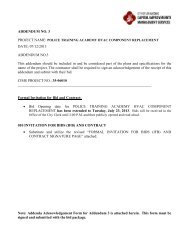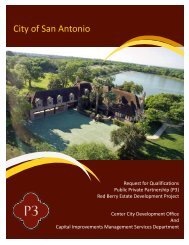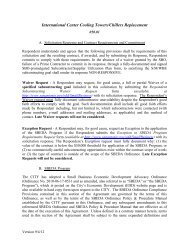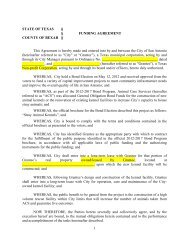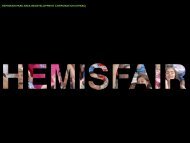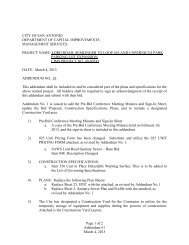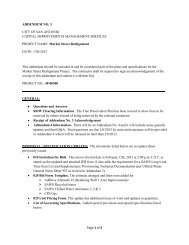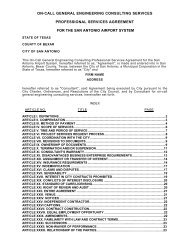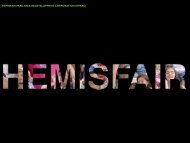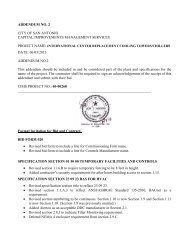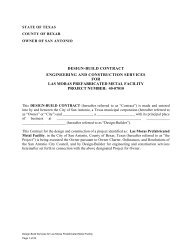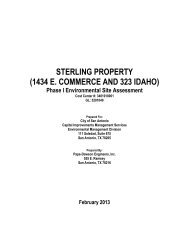Geotechnical Investigation Report - The City of San Antonio
Geotechnical Investigation Report - The City of San Antonio
Geotechnical Investigation Report - The City of San Antonio
- No tags were found...
You also want an ePaper? Increase the reach of your titles
YUMPU automatically turns print PDFs into web optimized ePapers that Google loves.
<strong>The</strong> liquid limit equipment setup consists <strong>of</strong> a brass cup partially filled with soil which is grooved<br />
with a specialized grooving tool, and then dropped freely from a specified height to the rubber base<br />
below at a constant rate <strong>of</strong> 2 drops per second. <strong>The</strong> liquid limit test is performed on soil that has<br />
been sieved through the No. 40 sieve and brought to a moisture content that would close the ½-<br />
inch groove within 20 to 30 blows for two consecutive tests. <strong>The</strong> moisture content <strong>of</strong> the soil is<br />
then measured and recorded as the liquid limit. <strong>The</strong> second part <strong>of</strong> the tests consists <strong>of</strong> a rolling a<br />
remolded sample between the tips <strong>of</strong> the fingers and a glass plate until transverse cracks appear at a<br />
rolled diameter <strong>of</strong> 1/8-inch. <strong>The</strong> moisture content <strong>of</strong> the rolled sample is taken and recorded as the<br />
plastic limit.<br />
3.2 Percent Passing the No. 200 Sieve<br />
Select soil samples were tested in accordance with ASTM D1140-00 to determine the amount <strong>of</strong><br />
material finer than the No. 200 sieve for use in classification. An oven dried sample <strong>of</strong> material is<br />
weighed then washed over a 75-µm (No. 200) sieve, allowing clay and other particles to be dispersed<br />
and removed from the soil. <strong>The</strong> retained material is oven dried then reweighed. <strong>The</strong> loss in mass<br />
resulting from the washing is calculated as mass percent <strong>of</strong> the original sample and is reported as the<br />
percentage <strong>of</strong> material finer than a No. 200 sieve.<br />
3.3 Moisture Content<br />
Moisture content testing was performed on select soil samples to determine the in situ state <strong>of</strong><br />
moisture <strong>of</strong> the soil. A fresh sample was weighed before being placed in an oven with a controlled<br />
temperature <strong>of</strong> 230°F and dried back to a constant mass. Upon the drying and reweighing <strong>of</strong> the<br />
sample, the total mass <strong>of</strong> water lost was recorded. <strong>The</strong> ratio <strong>of</strong> the water loss to the dried mass is<br />
recorded as the moisture content. This test was performed in accordance with ASTM D2216-10.<br />
3.4 Sulfate Determination<br />
Testing was performed on select samples to determine sulfate content in accordance with Tex-145-<br />
E, Determining Sulfate Content in Soils - Colorimetric Method.<br />
<strong>The</strong> sampling information obtained in the field was used in conjunction with the laboratory<br />
examination and testing to generate final boring logs, provided on Plates 4 through 7. A Key <strong>of</strong><br />
Terms and Symbols for the boring logs is provided on Plates 8A and 8B. <strong>The</strong> laboratory test results<br />
are provided on the final borings logs, as well as tabulated in Appendix A.<br />
4 SITE CHARACTERIZATION<br />
4.1 General Geology<br />
According to the Geologic Atlas <strong>of</strong> Texas, <strong>San</strong> <strong>Antonio</strong> Sheet (University <strong>of</strong> Texas Bureau <strong>of</strong><br />
Economic Geology, 1974), the proposed project is located within an area characterized by the Leona<br />
Formation (Qle) and the Pecan Gap Chalk (Kpg). A geologic map <strong>of</strong> the project vicinity is provided<br />
on Plate 2.<br />
<strong>The</strong> Leona Formation is comprised <strong>of</strong> fluviatile terrace deposits <strong>of</strong> gravel, sand, silt, and clay.<br />
<strong>The</strong> Pecan Gap Chalk is a very light yellow to yellow, chalk and chalky marl, which ranges in<br />
thickness from 50 to 75 feet.<br />
3



